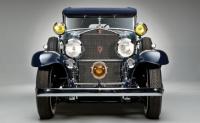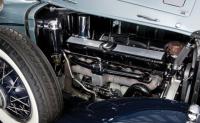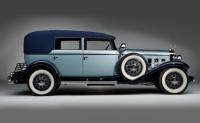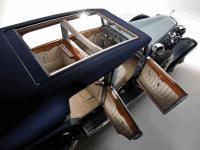Pozoruhodné dárky | Sběratelské předměty | AKČNÍ MODELY AUTÍČEK Die-Cast - 1/18 a další | Cadillac V16 Berline Convertible Sedan 1930 Blue Metallic Old-Time Livery 1/18 Die-Cast Vehicle
Cadillac V16 Berline Convertible Sedan 1930 Blue Metallic Old-Time Livery 1/18 Die-Cast Vehicle
| Věkové omezení: | 14 |
| Skladem: | na dotaz |
| Kategorie: | AKČNÍ MODELY AUTÍČEK Die-Cast - 1/18 a další AUTÍČKA PRO SBĚRATELE - MODELY 1/18 a další |
| Kód: | A39400 |
| Výrobce: | Unspecified |
Cena 14 993,00 Kč s 21% DPH
Model auta pro sběratele Cadillac V16 Berline Convertible Sedan 1930 by Sauotchik v modrém laku vytvořený podle předlohy originálu designerským týmem v měřítku 1:18 při věrném zachování detailu a kvality zpracování.
The Cadillac V-16 (also known as the Cadillac Sixteen) was Cadillac s top-of-the-line model from its January 1930 launch until 1940. The V16 powered car was a first in the United States, both extremely expensive and exclusive, with every chassis being custom-finished to order. Only 4076 were constructed in its 11-year run, with the majority built in its debut year before the Great Depression took strong hold. The onset of World War II reduced the sales, resulting in its demise.
The Cadillac V-16 was distinguished by its pioneering V-16 engine, a narrow 45° V angle OHV Series 452 displacing 452 cu in (7.4 L).
Upon its introduction the new car attracted rave reviews from the press and huge public attention. January production averaged a couple of cars per day, then ramped up to twenty-two. By April, 1,000 units had been built, and by June, 2,000 cars. These could be ordered with a wide variety of bodywork. The Fleetwood catalog for the 1930 V-16 included 10 basic body styles; there was also an envelope containing some 30 additional designer s drawings. Research by the Cadillac-La Salle Club, Inc. puts at 70 the number of different job/style numbers built by Fisher and Fleetwood on the Sixteen chassis.
What the feeling of the rumble of 16 cylinders at your command! You would have to go back 75 years to 1940 to find the last mass-produced V16 automobiles. Aside from the occasional limited-run exotic, the Cadillac V-16 (or Sixteen) stands as the only 16-cylinder automobile to have left a major auto factory in any real quantity. This venerable classic, which enjoyed two generations over the course of a decade, is not just that the Sixteen boasts so many cylinders that make it special. It also signified a number of important firsts for General Motors in that era—such as the decision to bring the design and crafting of luxury car bodies in-house, rather than contract them out to boutique shops (as was standard practice at the time).
Cadillac was facing an uphill battle bringing the Sixteen to life, as the stock market crash of 1929 and the ensuing Great Depression put a damper on sales of almost every automobile, not just ultra-luxury models. Still, the decision to develop the car had been made in 1927 — that giant behemoth first-generation 16-cylinder engine displaced 7.4 liters, and in many ways functioned as two separated straight-eight units packaged together and split by a 45-degree bank. The V16 generated a then-enormous 175 horsepower, with 320 pound-feet of torque also on tap—a number that dwarfed the 208 lb-ft produced by Cadillac s V8 of the time. It was also a remarkably smooth and silent motor, giving the Cadillac Sixteen a serious luxury leg-up over its competitors.
The two-door convertible coupe body style with rumble seat and removable hardtop is one of the almost 70 different configurations that could have been had with the V16 engine, including enormous limousine-style models and more restrained sedans. Perhaps the sportiest configuration of V16, the convertible coupe s classic proportions stand up as one of the more gorgeous, and almost impossible to find, examples of 1930s American engineering and design.
Production of the original V-16 continued under various model names through 1937. The body was redesigned in 1933 as the model 452C. Innovations included Fisher no draft individually controlled ventilation (I.C.V. or vent windows).
For 1934, the body was redesigned again and denoted as 452D, and as 452E in 1935. The V-16 now featured the Fisher Turret Top all-steel roof, though the cars were still built by Fleetwood. This same basic design would remain virtually unchanged through 1937. With a wheelbase of 154.0 inches (3,912 mm) and a curb weight of up to 6,600 pounds (3,000 kg) these are perhaps the largest standard production cars ever produced in the United States. Combined production for the 1934 and 1935 model years was 150. It was redesignated the Series 90 in 1936 as Cadillac reorganized their model names. Fifty-two units were sold that year, with nearly half ordered as limousines. Hydraulic brakes were added for 1937, the last year of production. Fifty vehicles were produced.
From 1930 to 1940, the Cadillac V16 was the top-of-the-line in luxury and power. Being the most expensive vehicle coming from Cadillac was no barrier for the wealthy tycoon and exclusivity and distinct looks were the icing on the cake. Only 4076 total variations of the V16 were built during its 11-year production period. The dual-windshields were aniconic design feature of the Sport Phaeton.
Mr. Monopoly s influence and power where complimented by the unique V16 engine. The structure resembled two inline eight-cylinder motors sharing a common crankshaft. Placed on 45-degree angles from each other, each half had its own fuel source and exhaust system. All that machinery and power was tamed by the use of an industry first overhead valve setup with hydraulic adjustment. This made the car extremely quiet during operation.
FEATURES:
• Detailed Engine • Steerable Front Wheels • Accurate Interior & Chassis • Opening Doors & Hood.
PLEASE NOTE: Due to the small edition size and the great demand for this item, allocations are expected to occur.
UPOZORNĚNÍ: TITUL JE VYROBENÝ V OMEZENÉM MNOŽSTVÍ JAKO UMĚLECKÝ PŘEDMĚT. UVEDENÁ PRODEJNÍ CENA JE PLATNÁ DO VYPRODÁNÍ TUZEMSKÝCH ZÁSOB.
The Cadillac V-16 (also known as the Cadillac Sixteen) was Cadillac s top-of-the-line model from its January 1930 launch until 1940. The V16 powered car was a first in the United States, both extremely expensive and exclusive, with every chassis being custom-finished to order. Only 4076 were constructed in its 11-year run, with the majority built in its debut year before the Great Depression took strong hold. The onset of World War II reduced the sales, resulting in its demise.
The Cadillac V-16 was distinguished by its pioneering V-16 engine, a narrow 45° V angle OHV Series 452 displacing 452 cu in (7.4 L).
Upon its introduction the new car attracted rave reviews from the press and huge public attention. January production averaged a couple of cars per day, then ramped up to twenty-two. By April, 1,000 units had been built, and by June, 2,000 cars. These could be ordered with a wide variety of bodywork. The Fleetwood catalog for the 1930 V-16 included 10 basic body styles; there was also an envelope containing some 30 additional designer s drawings. Research by the Cadillac-La Salle Club, Inc. puts at 70 the number of different job/style numbers built by Fisher and Fleetwood on the Sixteen chassis.
What the feeling of the rumble of 16 cylinders at your command! You would have to go back 75 years to 1940 to find the last mass-produced V16 automobiles. Aside from the occasional limited-run exotic, the Cadillac V-16 (or Sixteen) stands as the only 16-cylinder automobile to have left a major auto factory in any real quantity. This venerable classic, which enjoyed two generations over the course of a decade, is not just that the Sixteen boasts so many cylinders that make it special. It also signified a number of important firsts for General Motors in that era—such as the decision to bring the design and crafting of luxury car bodies in-house, rather than contract them out to boutique shops (as was standard practice at the time).
Cadillac was facing an uphill battle bringing the Sixteen to life, as the stock market crash of 1929 and the ensuing Great Depression put a damper on sales of almost every automobile, not just ultra-luxury models. Still, the decision to develop the car had been made in 1927 — that giant behemoth first-generation 16-cylinder engine displaced 7.4 liters, and in many ways functioned as two separated straight-eight units packaged together and split by a 45-degree bank. The V16 generated a then-enormous 175 horsepower, with 320 pound-feet of torque also on tap—a number that dwarfed the 208 lb-ft produced by Cadillac s V8 of the time. It was also a remarkably smooth and silent motor, giving the Cadillac Sixteen a serious luxury leg-up over its competitors.
The two-door convertible coupe body style with rumble seat and removable hardtop is one of the almost 70 different configurations that could have been had with the V16 engine, including enormous limousine-style models and more restrained sedans. Perhaps the sportiest configuration of V16, the convertible coupe s classic proportions stand up as one of the more gorgeous, and almost impossible to find, examples of 1930s American engineering and design.
Production of the original V-16 continued under various model names through 1937. The body was redesigned in 1933 as the model 452C. Innovations included Fisher no draft individually controlled ventilation (I.C.V. or vent windows).
For 1934, the body was redesigned again and denoted as 452D, and as 452E in 1935. The V-16 now featured the Fisher Turret Top all-steel roof, though the cars were still built by Fleetwood. This same basic design would remain virtually unchanged through 1937. With a wheelbase of 154.0 inches (3,912 mm) and a curb weight of up to 6,600 pounds (3,000 kg) these are perhaps the largest standard production cars ever produced in the United States. Combined production for the 1934 and 1935 model years was 150. It was redesignated the Series 90 in 1936 as Cadillac reorganized their model names. Fifty-two units were sold that year, with nearly half ordered as limousines. Hydraulic brakes were added for 1937, the last year of production. Fifty vehicles were produced.
From 1930 to 1940, the Cadillac V16 was the top-of-the-line in luxury and power. Being the most expensive vehicle coming from Cadillac was no barrier for the wealthy tycoon and exclusivity and distinct looks were the icing on the cake. Only 4076 total variations of the V16 were built during its 11-year production period. The dual-windshields were aniconic design feature of the Sport Phaeton.
Mr. Monopoly s influence and power where complimented by the unique V16 engine. The structure resembled two inline eight-cylinder motors sharing a common crankshaft. Placed on 45-degree angles from each other, each half had its own fuel source and exhaust system. All that machinery and power was tamed by the use of an industry first overhead valve setup with hydraulic adjustment. This made the car extremely quiet during operation.
FEATURES:
• Detailed Engine • Steerable Front Wheels • Accurate Interior & Chassis • Opening Doors & Hood.
PLEASE NOTE: Due to the small edition size and the great demand for this item, allocations are expected to occur.
UPOZORNĚNÍ: TITUL JE VYROBENÝ V OMEZENÉM MNOŽSTVÍ JAKO UMĚLECKÝ PŘEDMĚT. UVEDENÁ PRODEJNÍ CENA JE PLATNÁ DO VYPRODÁNÍ TUZEMSKÝCH ZÁSOB.
Zaregistrujte k odběru Newsletteru
Pozoruhodné knihy (Nakladatelství Pknihy publishing)
email: info@pknihy.cz
tomindo © 2012-2023, systém TomShop 2.5 | www.pknihy.cz | www.pozoruhodneknihy.cz | www.pozoruhodnedarky.cz











